|
|
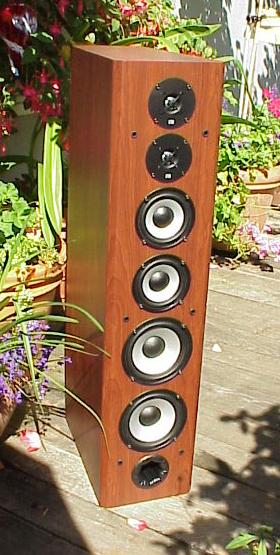 |
|
Specifications:
Drivers: Two 1" Titanium Dome Tweeters, Two, 5 1/4 Midrange, Two 6 1/2
Woofers; Ported Enclosure
MFR: 34 Hz - 22 kHz ± 3 dB
Nominal Impedance: 4 Ohms
Sensitivity: 95 dB/W/M (Room)
Size: 39 1/2" H x 9 1/4" W x 17" D
Weight: 57 Pounds Each
MSRP: $1,100/Pair
http://www.axiomaudio.com
|
|
Introduction
While most recently my interests have been in tweaking video, I have a much
longer history of playing with loudspeakers, building them, tweaking them,
using Fourier Analysis with sub-octave filtering to optimize equalization
and placement within the room, and of course, just plain old listening to
music. So when the editor asked me if I would be interested in reviewing a
pair of Axiom M80ti(s), my first response was, "Sure, I'll take these home
and measure their response and tell you what I see. John said, No, I've
done all that, just listen to them and tell me what you hear.
This was an intriguing challenge, as I enjoy technology and the Axioms
looked like very interesting technology, with two of just about everything,
except ports, of which there were three. But the thought of not using
technology to analyze the speakers was a bit intimidating, since I was going to
have to listen and write down what I heard, and make subjective judgments,
etc.
Fortunately, I have recently been doing a fair amount of music listening in
the process of tweaking my reference speakers, and so the chance to compare
my speakers to a recent example coming from the speaker design Mecca,
located in Ontario Canada, seemed too good to be true. (Axiom is one of
several loudspeaker companies located in the Ottawa area, and Axiom Audio's
founder, Ian Colquhoun worked directly with Dr. Floyd Toole at the nearby
National Research Council lab where many innovations in modern loudspeaker
design and analysis have been made.)
The reference speakers I used for the listening test are the speakers I use
up front in my Home Theater - Velodyne DF-661(s) (no longer available), I
also typically use a Velodyne 12 subwoofer for both music and Home Theater
purposes. Out of the box, the DF-661 speakers are a bit too bright, in my
opinion, and for years I had tamed this with a bit of equalization. The
recent addition of DVD-Audio to my system, where the EQ is bypassed, caused
me to seek alternatives to equalization, so I recently modified the
crossover to bring down the treble and midrange a bit relative to the bass.
For this reason, I was looking forward to a chance to compare my
recently tweaked Velodynes to the Axioms.
Hardware
The Axiom M80ti is an impressive looking tower speaker with two 6.5
woofers, two 5.25 midrange drivers, and two titanium 1 dome tweeters. The
drivers are mounted in an Anti-Standing-Wave cabinet that is narrower at the
back than in front. The manufacturer's specified frequency response is
34 Hz - 22 kHz ± 3 dB with a sensitivity of 91 dB and a nominal impedance of
4 Ohms. The recommended amplifier requirements are from 10 to 400 Watts.

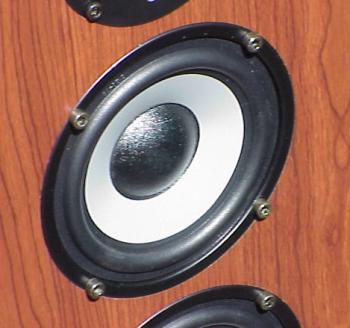
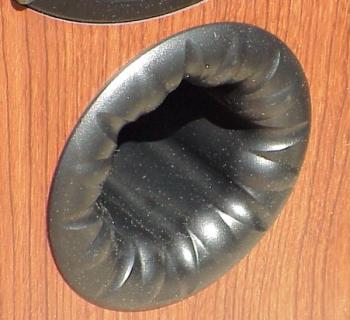
All of the above information should tell you that these speakers should be
capable of being played at high volume levels without much stress on the
drivers, except perhaps at the lowest frequencies.
The binding posts are of good quality and have the common spacing. I had no
trouble hooking up my speaker wires to them. Removable jumpers support bi-amping
or bi-wiring if that is required or desirable.

The Axiom M80ti(s) are available in three simulated wood grain vinyl
finishes: Maple, Black Oak, and Boston Cherry. The speakers I reviewed had
the Cherry finish, and I found the general fit and finish to be excellent.
The ports are lined with a leather-like material that has an interesting fluted
shape, presumably to reduce port-noise. I thought that the speakers looked
great without the front grilles, and that is certainly the way I would (and
did) use them. The Axiom M80ti are listed at $1,100 a pair.
Setup
I placed the two M80ti(s) in my Home Theater about 4 feet from the
acoustically treated front wall, and about 2.5 to 3 feet from the sidewalls
that also had high frequency absorbing drapes and tapestries to the sides of
the speakers. This placed the two speakers 6.5 feet apart and 12 feet from
my listening position. My HT, a.k.a., the family room, is a live end/dead end
design with extensive absorbing materials in the ceiling as well. There is
also a fair amount of dispersion at what I believe are appropriate places.
The amplifier used in the listening tests was an Acurus 200x3 that is
capable of delivering 200 Watts to 3 channels at 8 Ohms, and likely twice
that to 2 channels at 4 Ohms according to the tests I have seen.
The Music
Over the years, I have purchased many speakers, and helped a number of
friends do the same. I have found a few tracks on a few favorite CDs that
can be helpful in the selection process. Listening to music, as you know well,
can tell you a lot
about a speaker's overall characteristics and how well you might like
a speaker, or other component, in the long run.
So, the CDs I use to evaluate the M80ti are as follows:
Jennifer Warnes Famous Blue Raincoat Cypress Records DX 3182
Track 2, Bird on a Wire, has great drums and other percussion instruments,
and a complex vocal image with various voice-overs, etc. I have found that
with good speakers the image across the soundstage is very full and complex,
but with each voice or instrument well placed at various locations between
the two speakers. Track 3, Famous Blue Raincoat, is quite different. Here we
have an occasional saxophone and then Jennifer's unaccompanied voice. This
is a very simple image, but when well reproduced, the voice and the sax are
very detailed and rich, and with a stable centered image. Listening to these
two tracks with their very different presentations, back to back, can be
quite revealing. Bass response, clean treble and midrange for the female
voice, and imaging are keys here.
Natasha Chesky JD48
Whether you call it Rock or Jazz or Blues, this CD has a very up front
in-your-face presentation with both good vocals and instruments. I like the
music and listen to it to see how naturally the voice and the music, and the
club ambience are reproduced. The first track, NightBird, is as good as any
for this.
Kiri te Kanawa Verdi and Puccini CBS Records MK 37298
This has long been one of our favorite CDs for just listening to beautiful
music. It may not as pure as listening to the whole opera, but this CD
gives the best arias from a number of Verdi and Puccini Operas and Kiri is
certainly one of the best at delivering them. It's sort of like only eating
deserts and not getting fat. Track 9. O mio babbino caro, has been used in
various advertisements and is very popular, although it is from a seldom
performed opera. When you first listen to this CD, you will tend to turn the
volume control up quite a bit, e.g., 10 dB, as the recording level seems
rather low. This is not a mistake on the part or the recording engineer, he
or she was just saving the most significant bits of the digital format for
the tremendous dynamic range of Kiri's voice. When I first listened to this
CD many years ago, I was impressed at how loud some of the passages
sounded. Then I learned it was my amplifier clipping. Properly reproduced,
the loud passages don't sound loud at all, but clean and alive instead. This
CD will test midrange and tweeter power handling and distortion in these
same areas.
Bizet.Grieg Carmen, Peer Gynt Telarc Digital CD-80048
The passages on this disk are entirely orchestral. Track 1, from the Carmen
Suite, the Prelude to Act 1, starts with massed strings and properly
reproduced, gives a very detailed image with the strings spread evenly
across the entire front soundstage. A bit later on this track, there is a
transition or crescendo with enough impact to startle the unsuspecting, and
really test the system's dynamics. The sound here should be big and wide.
Later tracks contain both subtle and powerful passages.
Listening Tests
I started my evaluation of the Axioms by listening to the tracks of interest
with my reference speakers. I then moved the reference speaker cables to the Axioms,
which were placed at the location mentioned above and toed-in to point just
behind the listening area. I also turned off the subwoofer and set my
speaker choice to large in B&K Ref 30 preamp so that the Axioms would get a
full-range audio signal. Test tones showed the Axioms to be 3 dB more
sensitive than my reference speakers, and I adjusted the volume of the
various passages accordingly. The pink noise signal sounded decidedly
brighter than my reference speakers.
I started with the Carmen Suite, 1st track, and the massed stings seemed to
come from either the left or the right speaker locations, instead of being
well distributed across the front of the room. The strings also seemed a bit
strained or strident. Not a good start.
Natasha sounded harsh and nasal. It was too much in my face.
Then I put on Jennifer Warnes, probably the music I know best, and my first
thought was that something was missing from the high end but, at the same
time, the presentation seemed very forward and bright. Her voice had a bit
of grain or nasal quality that I was not used to hearing on this track. With
Bird on a Wire, the drums had good definition, but they were not as solid as with
my reference system (with a subwoofer). The cymbals sounded brittle. In
Famous Blue Raincoat, Jennifer's voice again had a harsh quality and was a
bit diffuse.
I did try the Kiri CD, and the power handling was fine, but it did not sound
as sweet as with the reference system.
I thought that perhaps the problem was in fact with my reference system.
Perhaps expecting another pair of speakers to sound as good to me as I was
the ones I had tweaked to my own taste was a bit naοve. In a way, I guess I
went to bed that evening pleased that my old Velodynes sounded as good as
they did in comparison.
The next day, I decided to give the Axioms another chance. After a few
trials listening to pink noise, the next music listening tests were
conducted with the speakers moved a bit closer to each other and pointed
straight ahead, instead of toed-in. I also hooked up the subwoofer so that
it would be more of an apples to apples comparison. When I tried Bird on a
Wire, my first reaction was Wow. The overall sound was now much more
balanced, the imaging greatly improved. The drums were well presented and
well positioned, with good impact, perhaps even better than with my
reference speakers. All those drivers in the Axioms were paying off after
all. Famous Blue Raincoat also sounded much better as well, but I'll have to
say that there was still a bit of graininess to Jennifer's voice in both
tracks that I was not use to. But now it was a bit harder to say which
presentation was right the Velodynes or the Axioms. Both were very good.
The imaging and tonal quality with the Puccini arias was also much improved
with the speakers in this orientation, and there was no doubt that the
Axioms handled the dynamics of the loud and demanding passages without any
sign of strain.
The massed strings with the Carmen Suite were now much better imaged and,
yes, the oomph was definitely there when called for. The image was also very
stable as I changed seating positions or walked around the room. It was
amazing to me, how much difference the orientation made, and I also think it
helped to have the high frequencies balanced by the use of the subwoofer to
extend the bass to the lowest frequencies. The Axioms now sounded very good,
perhaps not quite as clean and sweet as my Velodynes, but very good indeed.
Since my reference speakers were considerably more expensive than the more
modestly priced Axiom M80ti(s), I decided to get a third set of speakers
involved in the comparison test, speakers more similar in price. I had a
pair of Paradigm Monitor 7 v2 speakers that I use in another room for music
listening, and so I dragged them into my HT for a bit of more critical
listening. (The Paradigms use two woofers and one tweeter in a tower of a
similar size to the Axioms. Paradigm is also located near Ottawa.) I must
say that Jennifer or Kiri on the Paradigms sounded more like Jennifer or
Kiri on my Velodynes, rather than the somewhat grainier Jennifer or Kiri of
the Axiom's presentation. This might suggest that there is some
over-emphasis in the upper midrange or lower treble with the Axioms, perhaps
at the crossover, but it is likely very directional, and there is no doubt
that the placement and orientation of these speakers can have a major effect
on how it is perceived. In general however, I though that the Paradigms
sounded a bit heavy compared to the Axioms, while lacking much of their
impact and definition in the more dynamic passages. (I didn't try multiple
placements of the Paradigms.)
Home Theater
I did not try the Axioms for multi-channel HT listening. I don't think that
they would blend too well with my center speaker, a vertically oriented
DF-661. However, I have no doubt that their dynamics and power handling
capabilities would make the Axioms very well suited to the HT environment if
combined with a center speaker and surrounds of similar design.
On the Bench (JEJ)
Below is shown the measured frequency response, using MLS techniques. The
microphone was placed at a distance equal to the distance between the top
edge of the top tweeter and the bottom edge of the bottom woofer. The peak
at 4 kHz and rise above 10 kHz may explain Steve's impression that they can
be somewhat bright.

The test results from the distortion analysis are shown below. Except for
the 50 Hz test, all distortion results were lower than 1% THD. The tweeter
produced second, third, and fourth harmonics of the 5 kHz input fundamental,
with the third being the largest. At 1 kHz input fundamental, the midrange
driver produced several harmonics, the third being the largest, and also
some IM peaks, including two that can be seen just on either side of the 2
kHz harmonic.

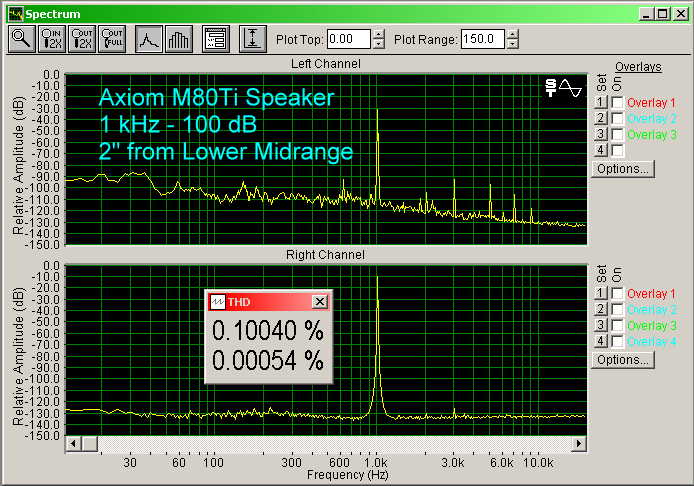
At 100 Hz input, the second harmonic was the largest one, and there are a
few IM peaks as well.

With a 50 Hz input, numerous harmonics were produced, and the third harmonic
was the largest.
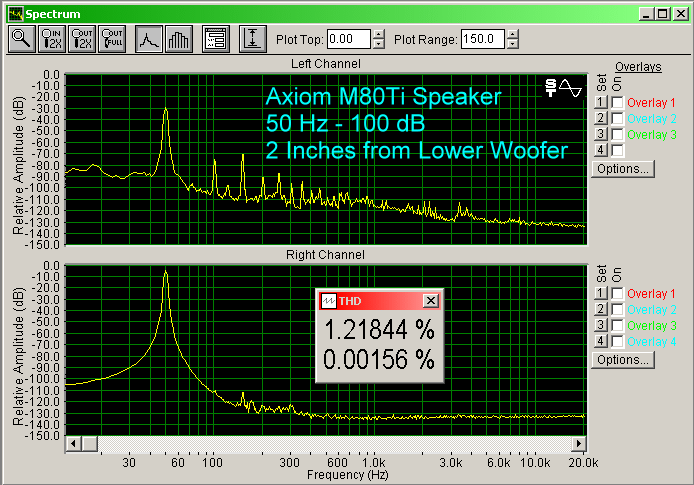
Conclusions
I found that the overall sound quality of the Axiom M80ti(s) was very good,
but only after careful orientation and positioning within the room. They
have excellent dynamics and power handling, and should serve anyone well for
either music or HT purposes. I do recommend, however, that you try them
before purchase, and see if you like the sound of the Axioms in your
environment. They can be a bit bright. Do try several placements and
orientation, and chances are, you will find one that works very well.
Equipment Used
Denon 1600 DVD player (for playing CDs)
B&K Ref 30 preamplifier
Acurus 200x3 amplifier
Adcom Power Center
KimberCable interconnects and speaker wire
- Steve Smallcombe -
Terms and Conditions of Use

|













